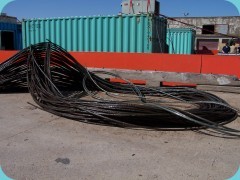Working out the bugs
Sorry for the long delay between updates. A lot of things were impacted by the weather today. As I write this evening, Argus is finally back in the water, and the crew is gathering in the main lab to watch the live video sent up by Argus' high definition camera.
The last two days have been about solving problems and working the bugs out of the system. At times it has seemed like a lot, but it's actually quite normal to have trouble getting all systems to work at the start of an expedition. Once the bugs are worked out, things usually go pretty smoothly, so we're hoping for that on this trip. I'll describe some of the challenges the team has been facing.
First it was the cable. Before the Carolyn Chouest had even left the dock in Galveston, the ROV team discovered that an electrical fault had damaged Argus' main cable, The cable is crucial. Not only does it support the ROV and allow it to be lowered into the water and raised again onto the ship, but the cable also carries electricity to power the vehicle and houses the fiber-optics that carry the all the video and data back to the surface. The electrical problem occurred about 1000 meters from one end of the cable, and the damage rendered that cable section useless. So the night before we left, the team cut off the first 1000 meters of cable and left it on the dock.

Once we were at sea, the science team was anxious to get the ROV in the water. They readied the ROV and launched it in relatively calm weather yesterday morning. Unfortunately the dive did not last long. When Argus first enters the water, the pilot lowers the vehicle to about 30 meters and stops in order to test all of the vehicle's systems. On the first dive, they discovered that a device called a "pinger" was not functioning properly. The pinger is an electronic beacon that helps determine Argus' location. If the ROV were lost on the bottom, the pinger would be needed to help find it. The team hauled Argus back up on the deck to replace the device.
Problems with the winch delayed the recovery. The winch is a large motorized drum that winds and unwinds cable to lower and raise the vehicle. With Argus finally on-board, much of the afternoon was spent working on Argus and preparing to get it back in the water. In the meantime, the production team and some of the scientists practiced for the live broadcasts.
By nighttime, Argus was ready to go back in the water. Unfortunately this time the dive was cut short by weather. The wind picked up during the night, and this caused bigger and bigger waves to form on the water. Around 2:00 am, when it looked like it might be dangerous to keep the ROV in the water any longer, the team brought Argus back to the surface.
The rough weather lasted throughout the night and most of today. This kept Argus out of the water and caused other problems as well. We lost our communications for a while because the high winds and rough seas were causing the satellite dish to vibrate so much that our signal was disrupted. The engineers were able to resolve this problem by asking the crew of the Carolyn Chouest to drive the ship so that they kept the satellite dish out of the wind as much as possible.
Luckily the weather started to get better this afternoon. With Argus back in the water, everybody is busy again and looking forward to surveying a coral cap on West Flower Garden Bank. Through all of this, I haven't mentioned the NR-1, but they have been working on their mission as well. As a submarine traveling below the surface, they have not been impacted as much by the weather as we have on the Carolyn Chouest. The plan is to meet up with the sub tomorrow so that a new team of scientists can get on the sub for the next dive.


